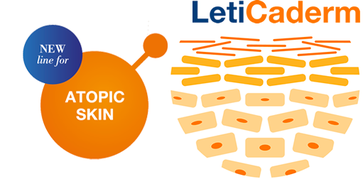LetiCaderm
The LetiCaderm line soothes the pruritus, restores the epidermal barrier, protects against irritants and controls pathogen overgrowth.
With scientifically-selected active substances, including polidocanol, myristyl phospho-malate, linoleic acid, linolenic acid and pomegranate polyphenols
Atopic dermatitis (AD) presents with:
Pruritus
Skin barrier dysfunction
Inflammation
Dysbiosis of skin flora
- Skin barrier dysfunction is associated with a lipid metabolism disorder and a dysfunction in the expression of proteins such as filaggrin. Studies show that dogs with atopic dermatitis have a lower concentration of sphingosine-1-phosphate (S1P), a specific sphingolipid that modulates cutaneous homeostasis.
- The skin barrier disorder leads to skin dryness, which exacerbates the pruritus and facilitates the penetration of environmental and microbiological irritants and allergens.
Pruritus, skin barrier dysfunction, inflammation and dysbiosis of skin flora
- Skin barrier dysfunction is associated with a lipid metabolism disorder and a dysfunction in the expression of proteins such as filaggrin. Studies show that dogs with atopic dermatitis have a lower concentration of sphingosine-1-phosphate (S1P), a specific sphingolipid that modulates cutaneous homeostasis.
- The skin barrier disorder leads to skin dryness, which exacerbates the pruritus and facilitates the penetration of environmental and microbiological irritants and allergens.
The LetiCaderm line exerts 4 effects:
Soothes the pruritus
Polidocanol: an antipruritic component which alleviates pruritus, the main symptom of atopic dermatitis (1).
Strengthens the skin barrier
Myristyl phospho-malate: An analogue of sphingosine-1-phosphate (S1P) which aids the synthesis of filaggrin and ceramides. It also activates the keratinocytes’ differentiation process and restores the skin’s water homeostasis (2,3,4,5).
Linoleic acid and linolenic acid: Essential fatty acids which are precursors of ceramide 1, a main lipid of the structural matrix (6,7).
Protects against irritants
Linoleic acid and linolenic acid: Essential fatty acids that act as precursors, with anti-inflammatory properties. Derivatives of safflower oil (Carthamus tinctorius) (6,7).
Controls the pathogenic flora
Pomegranate polyphenols: Active substances against Staphylococcus spp. and Malassezia spp. control the overgrowth of skin pathogens (8).
Productos de la línea
LetiCaderm SHAMPOO
- Indication: Cleaning and moisturising of atopic skin.
- Use: Apply once a week until remission of clinical symptoms in order to maintain the skin’s physiological conditions.
- Paraben-free and sulphate-free.
- 250 ml
Bibliography
- Hawro T, Fluhr JW, Mengeaud V, Redoulès D, Church MK, Maurer M, Metz M. Polidocanol inhibits cowhage - but not histamine-induced itch in humans. Exp Dermatol. 2014; 23: 922-3.
- Bäumer W, Rossbach K, Mischke R, Reines I, Langbein-Detsch I, Lüth A, Kleuser B. Decreased concentration and enhanced metabolism of sphingosine-1-phosphate in lesional skin of dogs with atopic dermatitis: disturbed sphingosine-1-phosphate homeostasis in atopic dermatitis. J Invest Dermatol. 2011;131: 266-8.
- Wood SH, Clements DN, Ollier WE, Nuttall T, McEwan NA, Carter SD. Gene expression in canine atopic dermatitis and correlation with clinical severity scores. J Dermatol Sci. 2009; 55:27-33.
- Yamamoto M, Kamata Y, Iida T, Fukushima H, Nomura J, Saito M, Tajima M, Okubo Y, Momoi T, Tsuboi R, Hibino T. Quantification of activated and total caspase-14 with newly developed ELISA systems in normal and atopic skin. J Dermatol Sci. 2011;61:110-7.
- Marsella R, Papastavros V, Ahrens K, Santoro D. Decreased expression of caspase-14 in an experimental model of canine atopic dermatitis. Vet J. 2016; 209:201-3.
- Reiter LV, Torres SM, Wertz PW. Characterization and quantification of ceramides in the nonlesional skin of canine patients with atopic dermatitis compared with controls. Vet Dermatol. 2009; 20: 260-6.
- Nishifuji K, Yoon JS. The stratum corneum: the rampart of the mammalian body. Vet Dermatol. 2013; 24:60-72.
- Ramió L, Cerrato S, Arosemena L, Calvo MA, Brazís P, Puigdemont A. Antimicrobial activity of pomegranate extract against canine skin pathogens. Oral communication and poster. 28th Annual Congress of the European Society and College of Veterinary Dermatology (ESVD). Krakow (Poland) 2015. Published in: Vet Dermatol 2015; 26: 300. Download poster - Download abstract
- Ramió-Lluch L, Brazís P, Puigdemont A. Aumento de ceramidas tras un tratamiento con esfingosina-1-fosfato en queratinocitos caninos. Poster. 54º Congreso nacional de Asociación Veterinarios Españoles Especialistas Pequeños Animales - South European Veterinary Conference (AVEPA-SEVC). Sevilla (Spain) 2019. Download poster








